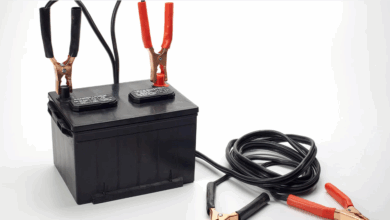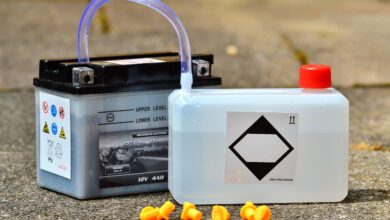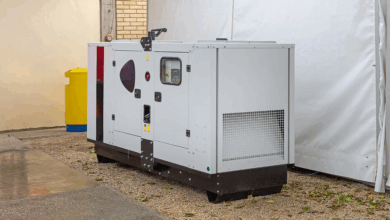Don’t Get Caught in the Dark: Top Home Generators Reviewed

Don’t Get Caught in the Dark: Top Home Generators Reviewed
The modern world relies on a steady flow of electricity. From keeping your refrigerator cold and your lights on to powering essential medical equipment and maintaining comfort with heating or air conditioning, a power outage can quickly turn from a minor inconvenience into a significant problem. Severe weather, grid failures, or even local issues can plunge homes into darkness, disrupting daily life and potentially causing financial loss (spoiled food, damaged electronics) or even posing safety risks.
This is where a home generator becomes less of a luxury and more of a necessity for many homeowners. A reliable generator provides peace of mind, ensuring that when the lights go out, your essential appliances – or even your entire home – can keep running. But with various types, sizes, and features available, choosing the right generator can be daunting.
In this article, we’ll break down the world of home generators, look at the different types, key factors to consider, and review some top contenders in the market to help you decide how to keep the lights on when the grid goes down.
Why You Need Backup Power
Beyond simply keeping the lights on, a home generator offers crucial benefits:
- Preserving Essentials: Keep refrigerators and freezers running to save hundreds of dollars in spoiled food.
- Maintaining Comfort: Power HVAC systems to stay warm in winter and cool in summer.
- Safety and Security: Operate security systems, lights, and communication devices (phones, internet).
- Medical Needs: Ensure essential medical equipment (oxygen concentrators, CPAP machines) remains operational.
- Work and Productivity: Maintain internet access and power for those who work from home.
- Property Protection: Keep sump pumps running to prevent basement flooding during storms.
Types of Home Generators
Understanding the basic types is the first step in choosing the right generator for your needs:
-
Portable Generators:
- Description: These are the most common and often the most affordable type. They run on gasoline, propane, or sometimes diesel, and are moved manually. They typically have multiple outlets for plugging in appliances directly or via extension cords.
- Pros: Relatively inexpensive, mobile (can be used at home, job sites, camping), easy to operate.
- Cons: Require manual starting and refueling, can be noisy, produce exhaust fumes (must be used outdoors only), generally less power than standby units, require extension cords or a manual transfer switch for home circuits.
-
Inverter Generators:
- Description: A type of portable generator known for producing "cleaner" electrical power, making them safe for sensitive electronics like laptops and smartphones. They are also typically quieter and more fuel-efficient than conventional portable generators.
- Pros: Quiet operation, clean power (safe for electronics), fuel-efficient, often lightweight and compact, some models can be linked together for more power.
- Cons: Generally more expensive than conventional portables of similar wattage, typically lower maximum wattage compared to large portable or standby units.
- Standby Generators:
- Description: These are permanently installed outside your home, much like an outdoor air conditioning unit. They are connected directly to your home’s electrical panel, usually via an automatic transfer switch (ATS). They typically run on natural gas or liquid propane (LP).
- Pros: Automatic operation (turn on automatically when power fails), can power essential circuits or even the entire house, run for long durations (especially on natural gas), significantly quieter than many large portable generators, add value to your home.
- Cons: High initial cost (unit plus professional installation), less flexible (fixed location), require professional maintenance.
Key Factors to Consider When Buying
Before looking at specific models, assess your needs based on these factors:
- Wattage: This is the most critical factor.
- Starting Watts (Surge Watts): The extra burst of power needed to start motor-driven appliances (refrigerators, HVAC, pumps).
- Running Watts (Rated Watts): The continuous power needed to keep appliances running.
- Calculate the total running watts of all essential items you must power simultaneously, then add the highest starting watts of any single appliance that will start while others are running. This gives you a minimum required wattage. It’s often wise to add a buffer.
- Fuel Type:
- Gasoline: Widely available, but has a short shelf life (especially with ethanol) and requires frequent refueling during long outages.
- Propane (LP): Can be stored for a long time, burns cleaner than gasoline, but is consumed quickly and large tanks are needed for extended use.
- Natural Gas: Provides an unlimited fuel supply via a gas line, ideal for long outages with standby units, but power output is slightly less than LP for the same engine size, and availability depends on your location.
- Diesel: Fuel-efficient and durable, common for very large commercial units, but fuel storage can be an issue for homeowners, and diesel generators are often louder and more expensive.
- Noise Level: Measured in decibels (dB). Portable generators are generally louder than standby or inverter types. Consider neighbors and proximity to living spaces. Look for models with mufflers or enclosed designs.
- Transfer Switch:
- Manual Transfer Switch: A switch installed in your electrical panel that safely disconnects your home from the utility grid and connects it to the generator. Required for safely powering home circuits with a portable generator.
- Automatic Transfer Switch (ATS): Used with standby generators. It automatically detects power loss, starts the generator, transfers the load, and shuts down the generator when utility power returns. Essential for seamless, hands-free operation.
- Budget: Portable generators are the least expensive upfront ($500 – $2,500+). Inverter generators are moderately priced ($800 – $4,000+). Standby generators have the highest upfront cost ($4,000 – $20,000+, including installation), but offer the most convenience and power.
- Features: Look for features like electric start, low-oil shutoff, fuel gauges, multiple outlets, portability kits (wheels, handles), parallel capability (for inverters), and remote monitoring.
Top Home Generators Reviewed (Examples)
Here are examples of top-rated generators representative of the different types and their strengths:
-
Generac Guardian Series (Standby)
- Type: Standby
- Key Features: Automatic operation with ATS, powers essential circuits or whole homes (available in sizes from 8kW to 26kW+), runs on natural gas or LP, Quiet-Test mode for regular self-testing at a lower RPM, remote monitoring via Mobile Link app.
- Pros: Seamless, automatic backup; permanently installed; reliable large-scale power; quiet relative to their power output; runs on readily available natural gas or LP.
- Cons: High initial cost and professional installation required; less fuel-efficient than some newer models (though improving).
- Ideal Use Case: Homeowners seeking permanent, automatic, hands-free backup for essential circuits or their entire home, especially where natural gas is available. The standard bearer in residential standby power.
-
Westinghouse WGen7500 (Portable)
- Type: Portable
- Key Features: 7500 running watts / 9500 peak watts, gasoline-powered, electric start (with battery included) and remote start key fob, includes GFCI outlets, built-in fuel gauge, heavy-duty frame with wheels and handle. Transfer switch ready outlet available on some models (WGen7500TF).
- Pros: Excellent power output for its price class, relatively affordable, electric start is very convenient, durable build, popular and well-reviewed model.
- Cons: Relatively noisy compared to inverters or standby units, requires manual fueling, heavier and less portable than smaller units.
- Ideal Use Case: Homeowners needing significant power for essential appliances (furnace fan, refrigerator, lights, sump pump, maybe a window AC) during an outage who are comfortable with manual operation and fueling. Also suitable for job sites.
- Honda EU2200i (Inverter)
- Type: Inverter Portable
- Key Features: 1800 running watts / 2200 peak watts, gasoline-powered, inverter technology provides clean power, exceptionally quiet operation (48 to 57 dBA), lightweight (under 50 lbs), fuel-efficient (runs 3.2 to 8.1 hrs on 1 gallon), parallel capability (can link two units for double the power).
- Pros: Famous for reliability and incredibly quiet operation, produces clean power safe for sensitive electronics, very portable, fuel-efficient.
- Cons: High price point for its wattage, lower maximum power than conventional portables (unless linked in parallel), requires manual start and fueling.
- Ideal Use Case: Camping, RVing, tailgating, powering sensitive electronics, or providing backup for a few essential items (lights, phone charging, TV) where quiet operation is paramount. Can serve as basic home backup when linked in parallel.
Note: This is not an exhaustive list, but represents popular and well-regarded models across different categories. Many other reputable brands like Champion, Kohler, and Cummins offer excellent generators as well.
Installation and Maintenance
Proper installation and regular maintenance are crucial for safety and reliable operation.
- Installation: Standby generators must be installed by a qualified professional (electrician and/or plumber for gas connection) following all local codes. Portable generators must always be used outdoors in a well-ventilated area, far away from windows and doors, to prevent deadly carbon monoxide buildup. Using a portable generator to power home circuits requires a properly installed manual transfer switch or interlock kit; plugging it directly into a wall outlet (backfeeding) is extremely dangerous and illegal.
- Maintenance: All generators require regular maintenance, including oil changes, filter checks/replacements, spark plug inspection, and testing. Standby generators often have maintenance plans available through dealers. Portable generators should be run periodically (e.g., quarterly) to ensure they start and run correctly, especially if using gasoline which degrades over time (use a fuel stabilizer!).
FAQs
- How do I figure out what size generator I need?
Calculate the total running watts of everything you want to power simultaneously. Add the highest starting watts of any single appliance that will cycle on. Choose a generator with running watts at least equal to your total running watts calculation, and starting watts at least equal to your total running plus the highest starting watt appliance. It’s better to slightly oversize than undersize. Consult with an electrician for whole-home or essential-circuit sizing. - What’s the difference between running watts and starting watts?
Running watts is the continuous power an appliance uses once it’s on. Starting watts is the brief surge of extra power needed when a motor-driven appliance (like a refrigerator or air conditioner) first kicks on. - Can I use a portable generator indoors?
Absolutely NOT. Portable generators produce carbon monoxide, an odorless, colorless, deadly gas. They must always be used outdoors, far away from windows, doors, and vents (at least 20 feet is recommended). Install carbon monoxide detectors in your home. - Do I need a transfer switch?
Yes, if you want to power circuits in your home’s electrical panel with a generator. A transfer switch safely disconnects your home from the utility grid, preventing dangerous "backfeeding" electricity onto the grid (which can harm utility workers) and preventing the generator from being damaged when utility power is restored. Standby generators come with or require an automatic transfer switch (ATS); portable generators require a manual transfer switch or interlock kit for home circuit use. - How loud are generators?
It varies significantly by type. Inverter generators are the quietest (often 50-60 dB). Standby generators are moderately loud but often sound more like an AC unit (60-70 dB measured from a distance). Conventional portable generators are the loudest (often 70-80+ dB), comparable to a lawnmower. Noise levels are usually listed in the specifications. - What’s the best fuel type?
It depends on your needs. Natural gas is ideal for long-duration standby power if you have a gas line. Propane is great for standby or portable if you need long-term storage and cleaner burn than gasoline. Gasoline is convenient for portable use but requires frequent refueling and storage considerations. - How long can a generator run?
This depends on the fuel source and fuel consumption rate. Portable generators run until their fuel tank is empty (typically 6-12 hours per tank on a moderate load). Standby generators on LP tanks will run until the tank is empty. Standby generators on natural gas can run continuously as long as the gas supply is uninterrupted. Always check the generator’s specifications for run time at various load levels.
Conclusion
Power outages are an increasing reality for many communities. Investing in a home generator is an investment in comfort, safety, and peace of mind. Whether you choose the automatic, whole-home power of a standby generator like the Generac Guardian, the versatile and powerful backup of a portable unit like the Westinghouse WGen7500, or the quiet, clean power of an inverter like the Honda EU2200i, having a plan for backup power is crucial.
Consider your specific needs – what absolutely must run during an outage? What’s your budget? How important is convenience, noise level, and fuel storage? By evaluating these factors and understanding the types of generators available, you can select the right unit to ensure that when the power goes out, you and your family won’t be caught in the dark. Consult with professionals where needed for installation and sizing to ensure safety and optimal performance.




![How to Bypass CO Sensor on Generator – [4-Step Safety Guide]](https://www.generator411.com/wp-content/uploads/2025/08/co-sensor-on-generator-390x220.png)